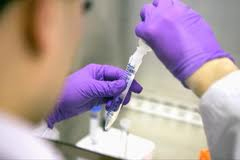Enzyme level linked to green muscle disease in poultry

After more than a decade of research into an increasingly common and costly broiler condition known as green muscle disease, a team of poultry scientists at Auburn University has identified a blood enzyme that could give breeders a noninvasive tool to screen birds for susceptibility to the disease.
Elevated levels of the enzyme, creatine kinase, can signal muscle breakdown and damage. In humans, high levels of the enzyme in the blood can be indicators of heart attack, muscular dystrophy, acute renal failure and other serious muscle conditions. In broilers, they indicate the development of green muscle disease.
Technically called deep pectoral myopathy, green muscle disease is a degenerative condition of broiler chickens’ minor pectoral muscles, or tenders, that causes the muscle tissue to bruise. The discolored tissue is not discovered until processing and deboning, and then it must be trimmed and discarded, costing the US poultry industry an estimated $50 million a year in losses.
Also of concern to the industry is the occurrence of green muscle disease in birds marketed as whole carcasses or bone-in parts, because the condition is rarely detected during processing, resulting in consumer complaints.
Auburn poultry science professor Joe Hess – who, with departmental colleagues Sarge Bilgili and Roger Lien, has conducted extensive research on the disease – says the condition is caused by sudden, excessive wing flapping, especially when that occurs one to two days before slaughter.
“Green muscle disease is an exercise issue,” Hess said. “If you have a house full of chickens and there’s a sudden loud noise or some other environmental stressor, they’re going to get scared and agitated and start flapping their wings. If it’s late in the growing season, that’s when the damage occurs.”
During wing movement, blood flow increases to a bird’s major and minor pectorals, or breast muscles, causing the tissues to swell. Though the swelling doesn’t affect the larger breast fillet muscle, the tender has a more rigid covering and is confined to a tighter space. The swelling so compresses the muscle that the blood supply is cut off and the tissue bruises.
Early in the team’s green muscle research, Lien perfected a technique, “encouraged wing flapping,” to assess birds’ susceptibility to the condition and determine factors that contribute to development. Using that procedure, the scientists have found that broiler strains bred for higher breast-meat yields are more likely to develop the disease, as are broilers marketed at heavier weights and, to a degree, male birds.
They also found correlations between temperature and disease incidence.
“When the weather is hot, broilers grow at a lot slower rate than in cooler weather,” Hess said. “But cool to normal temperatures are periods of rapid growth, and broilers that get agitated during those periods have a greater likelihood of muscle damage.”
In their latest focus on the relationship between creatine kinase levels and deep pectoral myopathy, the Alabama Agricultural Experiment Station scientists induced excessive wing activity and then measured enzyme levels one to four days after the trials.
At processing, they discovered that broilers in which levels of the enzyme had jumped significantly post-flapping were far more likely to have muscle damage to the minor pectorals, leading them to conclude that encouraged wing flapping and creatine kinase levels could be used as tools in genetic selection programs to screen for green muscle disease susceptibility.
Join 31,000+ subscribers
Subscribe to our newsletter to stay updated about all the need-to-know content in the poultry sector, three times a week. Beheer
Beheer








 WP Admin
WP Admin  Bewerk bericht
Bewerk bericht